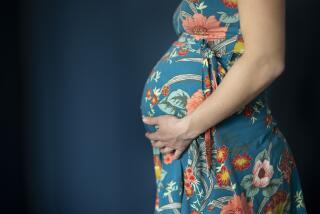Traffic Accident Testers to Study Fate of Pregnant Women : Safety: Even low-speed crashes can threaten the health of an unborn child. It’s an unexplored area.
- Share via
DETROIT — Several thousand American women are involved in traffic accidents each year while pregnant, and even low-speed crashes can threaten the health of an unborn child.
With that fact in mind, researchers from General Motors Corp. and the University of Michigan have developed a “pregnant” test dummy to measure how crashes affect mothers-to-be and fetuses.
“This one (a pregnant woman) is probably the last member of the family to be studied in crash tests,” David Viano, a biomedical engineer who is principal research scientist for GM, said Thursday.
The company already runs tests with dummies that simulate infants, 3- and 6-year-olds, and adults of various sizes.
The new member of the crash-test family is a modified version of a state-of-the-art female dummy. She’s 4-foot-11, 110 pounds and in her seventh month of pregnancy. Inside is a simulated 7-month fetus suspended in urethane gel that mimics amniotic fluid.
“The toughest thing is looking at what happens to the placenta in a motor vehicle crash,” said Dr. Mark Pearlman, assistant professor of obstetrics and gynecology at Michigan and Viano’s partner in the research. “A majority of the pregnancy losses in minor crashes is caused by . . . the separation of the placenta from the uterus.”
Scientists don’t completely understand what causes that to happen, but when it does happen, it deprives the fetus of oxygen.
By adding sophisticated sensing devices to the pregnant dummy, they hope to find a way to measure forces that affect the placenta in a crash.
“We’ve started refining the dummy tummy,” Pearlman said. “The real question becomes: What is the safest restraint system for the pregnancy itself?”
His answer today is emphatic: “It is clear that safety belts save lives. It’s also clear that when you compare pregnant women who buckle and those that do not, those who buckle suffer fewer injuries in crashes.”
Research with the pregnant crash dummy will help engineers develop safety systems specifically designed for pregnant women.
“My suspicion is the whole occupant restraint system hasn’t really been optimized for pregnant women,” Viano said.
Laboratory crash tests with the prototype dummy began about two weeks ago. “We want to use the first set of data to reinforce the advice on proper use of belts,” Viano said.
Pearlman, Viano and the physician group agree on that advice: Pregnant women should wear the lap portion of safety belts as low as possible, under the abdomen’s bulge. The shoulder portion should be worn between the breasts and off to the side of the bulge.
In the upcoming tests, a sled on a track will be crashed carrying the dummy in several configurations: unbelted, belted improperly, belted properly and with and without air bags.
There is substantial research that shows air bags reduce injuries in certain crash conditions, Pearlman said.
“There’s every indication that the same would be true for a pregnant woman,” he said. “But because there are rare instances when people are injured by air bags, it’s appropriate for us to do testing with the dummy tummy.”






